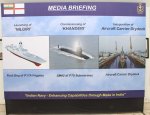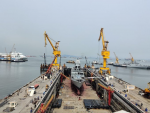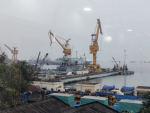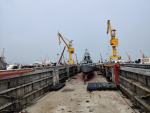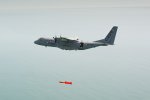Two Indian navy ships make port call at Laem Chabang
Chon Buri: Indian navy ships Sahyadri and Kiltan made a port call at Laem Chabang seaport in this eastern province to boost bilateral ties and ensure secure access to the Indian Ocean.
The two vessels left the port and conducted a passage exercise at sea Tuesday night with the Royal Thai Navy.
Suchitra Durai, the Indian ambassador to Thailand, said the two military ships docked at the Laem Chabang port from Saturday until Wednesday, as part of the Indian Navy’s overseas deployment to Southeast Asia and the Western Pacific.
“The port call is a demonstration of India’s warm ties with Thailand. There are professional interactions between naval officers, official calls, and other events during the port call,” she told the press conference on Monday. INS Sahyadri, a frigate and INS Kiltan, a corvette, are part of the Indian navy’s Eastern Naval Command, the flag bearer of India’s Act East policy.
The ships, equipped with state of the art weapons and sensors, represent the coming-of-age of Indian warship building capabilities.
Mr Durai said defence cooperation is the main component of bilateral engagement, hence many naval activities.
“A few years ago, India and Thailand signed an MoU on defence cooperation. In December [last year], the chief of the Royal Thai Navy visited India. In April, the chief of the Indian Navy came to Thailand.
“We plan many visits over the next few months. Our defence cooperation is very robust.
"A few days from now, we are going to have a coordinated patrol exercise along the western coast of Thailand in the Andaman Sea.
"Later on, we are going to have the first trilateral exercise with Thailand and Singapore in the Bay of Bengal,” she said.
When asked about India’s maritime objectives, the ambassador said the Indian navy is at the forefront of ensuring the Indian Ocean and others are safe and secure.
“That is the bread and butter of every country because we live in an interdependent world. We are extremely dependent on traffic and trade in the Indian Ocean and what is called the East India or the Indo-Pacific,” she said.
Two Indian navy ships make port call at Laem Chabang
Chon Buri: Indian navy ships Sahyadri and Kiltan made a port call at Laem Chabang seaport in this eastern province to boost bilateral ties and ensure secure access to the Indian Ocean.
The two vessels left the port and conducted a passage exercise at sea Tuesday night with the Royal Thai Navy.
Suchitra Durai, the Indian ambassador to Thailand, said the two military ships docked at the Laem Chabang port from Saturday until Wednesday, as part of the Indian Navy’s overseas deployment to Southeast Asia and the Western Pacific.
“The port call is a demonstration of India’s warm ties with Thailand. There are professional interactions between naval officers, official calls, and other events during the port call,” she told the press conference on Monday. INS Sahyadri, a frigate and INS Kiltan, a corvette, are part of the Indian navy’s Eastern Naval Command, the flag bearer of India’s Act East policy.
The ships, equipped with state of the art weapons and sensors, represent the coming-of-age of Indian warship building capabilities.
Mr Durai said defence cooperation is the main component of bilateral engagement, hence many naval activities.
“A few years ago, India and Thailand signed an MoU on defence cooperation. In December [last year], the chief of the Royal Thai Navy visited India. In April, the chief of the Indian Navy came to Thailand.
“We plan many visits over the next few months. Our defence cooperation is very robust.
"A few days from now, we are going to have a coordinated patrol exercise along the western coast of Thailand in the Andaman Sea.
"Later on, we are going to have the first trilateral exercise with Thailand and Singapore in the Bay of Bengal,” she said.
When asked about India’s maritime objectives, the ambassador said the Indian navy is at the forefront of ensuring the Indian Ocean and others are safe and secure.
“That is the bread and butter of every country because we live in an interdependent world. We are extremely dependent on traffic and trade in the Indian Ocean and what is called the East India or the Indo-Pacific,” she said.
Two Indian navy ships make port call at Laem Chabang

